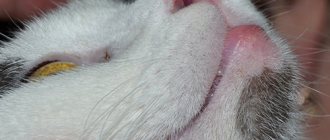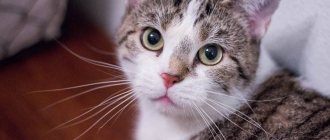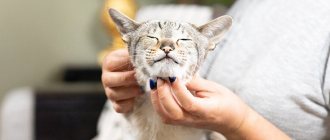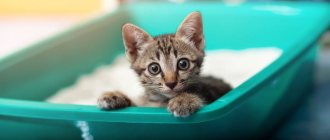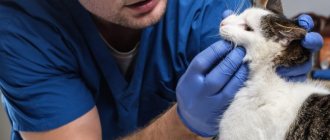03/31/2021 51,646 Diseases and treatment of cats
Author: Olga
If, after taking a closer look at your cat, you notice a strange swelling on her lips, it’s time to sound the alarm. This condition may have a lot of explanations, accompanying symptoms and diagnoses, but it clearly does not bode well. What should I do if my cat’s lower lip is very swollen and will the use of Dexamethasone and Sinulox help in this case? Now we'll figure it out!
[Hide]
Possible causes of swelling
Naturally, you can speculate for as long as you like what exactly caused the strange swelling on your pet’s lips, but only a veterinarian can make an accurate diagnosis based on the totality of the symptoms. You need to try to give as much information as possible about the disease and most likely your cat will be given one of the following diagnoses.
Swelling on the lip
Injury
Injuries are not uncommon for cats, including lip injuries. Most often, an animal injures its lips or gums by eating too hard food, bones, or licking cans of canned food. And even if your cat is a home cat and you carefully monitor his diet, he may secretly steal a bone or pull a dangerous can out of the trash can. Backyard animals are especially susceptible to lip injuries. They can be stung by a wasp or a bee, or injured by thorny bushes.
Lacerations on the lips caused by cat fights are not uncommon. Any damage to the delicate skin of the lips is dangerous due to secondary bacterial infection. Therefore, if you notice such an injury, be sure to treat it with an antiseptic and put the animal on a gentle diet. Give only soft food or porridge, exclude dry granular food or bones. In rare cases, when injuries on the lips are lacerated with severe bleeding, surgical intervention may be necessary - such wounds will need to be stitched.
Burn
Burns of the mouth and lips in cats can be thermal, chemical and electrical. Note that thermal burns are an atypical situation for cats; they do not rush to hot food, no matter how hungry they are. However, they may lick hot pans or grates. A chemical burn can occur if the animal has ingested some toxic substance, in which case poisoning can also occur.
A cat that has a bad habit of chewing wires can get a dangerous burn to its lips and mouth. This behavior can result not just in a burn, but also in death.
Therefore, a cat injured by electric current must be shown to a veterinarian. Mild forms of lip burns can be treated at home if the symptom is only mild redness. To do this, the affected area is washed with clean water and covered with sterile gauze or cloth.
Gingivitis
Gingivitis in cats is a local disease of the oral cavity. It is characterized by inflammation of the gums and the presence of a red border around the tooth.
Gingivitis in cats has the following symptoms:
- unpleasant odor from the mouth;
- inflamed, swollen gums, bleeding may occur;
- soreness in the gums and lips;
- drooling, poor appetite.
Gingivitis in the mouth
Gingivitis in cats can occur in chronic or acute form. The cause of this unpleasant disease can be dental diseases - plaque, tartar. As well as immune disorders, calcivirosis, rhinotracheitis virus and panleukopenia. Sometimes gingivitis is observed as a concomitant disorder with severe systemic diseases such as diabetes mellitus, liver or kidney failure. In principle, any state of immune depression makes the pet's mouth and lips especially vulnerable. Without treatment, gingivitis ends in tooth loss.
Eosinophilic granuloma
Another reason why a cat has a swollen lower lip can be eosinophilic granuloma. The disease is caused by an allergic reaction to insect bites, hypersensitivity to food or environmental components. It is expressed in damage to the mucous membranes of the mouth and lips. The name eosinophilic granuloma supposedly comes from the name of the cells - eosinophils, which are the cause of the disease. Eosinophils belong to white blood cells, cells that are the basis of the body's immune system.
Manifestations of eosinophilic granuloma
With eosinophilic granuloma, swelling, papules, and plaques are observed in the animal’s oral cavity, and most often the disease is painless. But you should beware of the swallowing disorder that accompanies granuloma, which can lead to exhaustion of the animal. Diagnosis of granuloma can be complicated by the fact that fungal or bacterial lesions of the mucous membranes can have similar symptoms.
Cytology of smears should help, which in case of eosinophilic granuloma will contain an increased number of eosinophils. To treat granuloma, the first step is to try to establish which allergen caused it.
Fungal infection
Fungal infections rarely lead to serious damage to the mucous membranes. Most often, mycoses can be observed on the animal’s body. However, candidiasis of the oral and lip mucosa can be associated with skin maceration - the process of moisturizing and swelling of the epidermis due to prolonged contact with liquid. The presence of Candida yeast fungi on the lips is most often associated with immune disorders or long-term and unjustified use of glucocorticosteroids.
Swelling on the lower lip
Infection with fungi of the genus Candida is often called fungal stomatitis and its symptoms are white plaques in the mouth and on the tongue of the animal. Treatment of fungal infections requires complex treatment; it is necessary to eliminate their root cause, for example, immune depression. And use local antifungal drugs.
Tumor
Tumors in the mouth are rare in cats. Alas, if they do occur, they are more likely to be malignant.
Benign formations include gingival fibroma and epulis. Both formations grow on the gum, only the fibroma is larger in size. Fibroma may have the color of the gum itself or be paler, it is insensitive, and feels firm to the touch. Treatment is surgical removal. You can see what a cat looks like after a tumor in his mouth has been removed in the video below.
The most common malignant tumor in the oral cavity is squamous cell carcinoma. The tumor grows from the cells of the mouth and throat, accompanied by the appearance of non-healing ulcers, salivation and an unpleasant odor. It quickly spreads through neighboring tissues and lymph nodes, causing severe swelling. It is difficult to treat, surgical removal and radiation therapy do not always lead to positive results, and the mortality rate from carcinoma is high and painful.
Diagnosis of the disease
Before answering the question of what to do with a tumor on the lip and how to treat this painful symptom, owners should understand that without qualified diagnostics there is a high probability of using therapy that will not be aimed at the true cause of the disease. Therefore, when a swollen lip is first detected, the owner is obliged to take the cat for examination to a veterinarian.
In a veterinary hospital, the doctor will collect an anamnesis (the cat’s medical history) from the owner’s words. After which a full clinical examination of the patient will be carried out to check for insect bites, snake bites, problems with teeth and gums, as well as signs of the cat being infected with infectious agents. In most cases, this is enough to accurately differentiate the diagnosis.
Sometimes additional ultrasound and x-ray examination may be required. If the tumor has clear boundaries and there is every reason to suspect the oncological nature of the symptom, then it is permissible to do a biopsy (taking the affected tissue from the cat’s lip).
How to cure a pet?
Of course, treatment does not need to begin until a final diagnosis is made. Each of the described conditions requires an individual treatment regimen. The drug Dexamethasone is often used to treat conditions that cause swollen lips and lesions in the mouth. Dexamethasone has the active ingredient dexamethasone disodium and is available in the form of injection ampoules. Dexamethasone has anti-inflammatory, anti-allergic and anti-shock effects.
In case of infectious lesions, Dexamethasone complements antibiotics. Dexamethasone should be given in the dosages specified in the instructions for use. Another drug that has a detrimental effect on a number of pathogenic microorganisms is Sinulox. Sinulox is available in the form of a suspension or tablets. Sinulox is effective for infectious lesions of soft tissues and mucous membranes. Sinulox is often prescribed for gingivitis. Sinulox should be given strictly according to the instructions for use. There is a tablet form of Sinulox.
Associated symptoms
If a cat's lower lip is swollen, then this in itself is a symptom of various kinds of pathological processes in the body. However, in most cases, if the lip is swollen, it happens for completely harmless reasons. You should be wary only if there are accompanying negative signs.
Alarming symptoms:
- hard swelling structure;
- increased body temperature;
- lack of appetite;
- discharge of pus;
- blisters on the mucous membrane;
- the lip turned red;
- significant swelling;
- bad breath;
- spread of the tumor to surrounding tissues;
- discharge from the eyes and nose.
© shutterstock
Video “Brushing pets’ teeth”
To avoid many of the problems described above, it is enough to monitor your pet’s oral hygiene. The video below will tell you how to brush your pets' teeth at home and in the clinic.
Sorry, there are no surveys available at this time.
Was this article helpful?
Thank you for your opinion!
The article was useful. Please share the information with your friends.
Yes (100.00%)
No
X
Please write what is wrong and leave recommendations on the article
Cancel reply
Rate the usefulness of the article: Rate the author ( 15 votes, average: 4.53 out of 5)
Discuss the article:
Treatment of a cat's lip ulcer
Treatment is complex, in uncomplicated cases it comes down to the use of immunocorrection drugs, corticosteroids, and local treatments. Treatment must be timely and under the supervision of a veterinarian. In this way, it is possible to avoid dangerous complications.
Prices for appointments in our network of veterinary clinics
| Name of veterinary services | Unit | Price, rub |
| ⭐ Initial appointment | 1 animal | 400 |
| ⭐ Repeated appointment | 1 animal | 250 |
| Initial appointment with a specialist | 1 animal | 1100 |
| Consultation without an animal | — | 550 |
| Consultation with a doctor based on test results | 1 PC. | 400 |
| Weighing animals | 1 animal | For free |
| Additional fixation for aggressive animal behavior | 1 animal | 700 |

